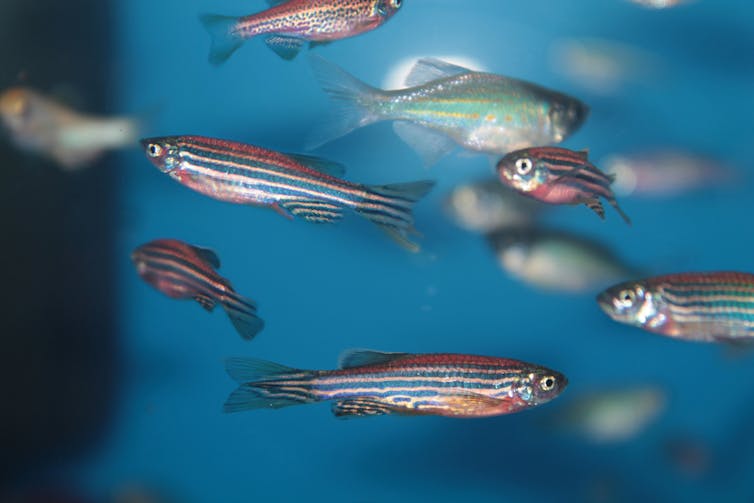Tuberculosis, humanity’s greatest infectious killer, is caused by bacteria that usually affect the lungs but can also affect many other organs in the body. In 2021, around 10.6 million people worldwide fell ill with tuberculosis (TB) and 1.6 million people died from the disease.
However, around 95% of people who are infected with the bacteria that cause TB don’t become ill. Their immune system manages to successfully destroy the bug.
My colleagues and I are interested in what makes some people susceptible to TB, while others appear to be protected. We use zebrafish to study the disease as their immune systems share many similarities with those of humans, and it is possible to manipulate their genes in the lab. In our latest study, published in the online journal PNAS, we have used this kind of manipulation to show the genes carried by many Ashkenazi Jews that put them at a higher risk of a rare disease also help protect them against TB.
Our team had previously found that zebrafish with genetic mutations in certain enzymes in their cells became more susceptible to TB. These enzymes are found in the cells’ lysosomes, components that break down unwanted material including proteins and fats. When the production of these enzymes is reduced, it can lead to a build-up of toxic material.

One type of cell that is vulnerable to this build-up is the macrophage, a cell that “eats” toxic material, including bacteria and waste products. In lysosomal disorders, the macrophages move slowly and become enlarged because they accumulate undigested material in their lysosomes, making them less able to fight infection.
Macrophages need to move quickly to attack invading bacteria and viruses. Their name means “big eater”, and this is exactly what they do. But with lysosomal disorders, they’re unable to break down the food they eat, which makes them bloated and sluggish, unable to perform their duties.
Resistant to infection
However, when our group genetically engineered zebrafish to model one of these lysosomal disorders, called Gaucher disease (pronounced go-SHAY), we found something very unexpected: these fish were TB-resistant rather than susceptible.
Gaucher disease is a rare disease that can affect anyone, but rates are significantly high among Ashkenazi Jews – around one in 800 births. In most cases, the illness can be relatively mild, with symptoms including enlarged spleen and liver, and anaemia. Around two-thirds of people carrying two copies of the most common genetic variant are unaware they are carriers.
We made zebrafish with genetic variants that cause Gaucher disease in Ashkenazi Jews and, as expected, their macrophages became enlarged and could not break down an unusual type of fat called sphingolipids. Yet when the fish were exposed to TB, we were surprised to discover that they were resistant to infection.
The reason for this resistance to infection was because of the fatty chemical that accumulates in the macrophages in Gaucher disease. This fatty chemical was found to act as a solvent that can kill TB bacteria within minutes by disrupting their cell walls.
These fish unknowingly landed us in a debate that’s been going on in human genetics for decades: are Ashkenazi Jews – who we know are at a much greater risk of Gaucher disease – somehow less likely to get TB infection? The answer appears to be yes.
The Ashkenazi Jewish diaspora has experienced centuries of persecution, often forced to live in ghettos and migrate from country to country. They would have been highly exposed to TB, which spreads more widely among poorer living conditions and densely populated urban areas.
These genetic variants can increase the risk of Gaucher disease, but they also help protect against TB, giving them a selective advantage – that is, making the variants more likely to be passed down from generation to generation and therefore spread within the population. A similar phenomenon is seen in groups where people carry genetic variants that protect them from malaria but when more than one copy is present, causes harmful anaemia or even sickle cell disease.
Unlike the example of sickle cell anaemia, however, only people who carry two copies of the Gaucher genetic variant – one from each parent – are likely to be protected against TB. That’s because having one “healthy” gene generates enough of the enzyme to clear the bacteria-killing fatty chemical so that it does not accumulate.
This discovery may provide clues to possible new treatments for TB. Drugs that mimic the effects of Gaucher disease – specifically the build-up of the fatty chemical that acts as a solvent – might be useful in the global fight against TB.
Lalita Ramakrishnan receives funding from the Wellcome Trust, UK and the National Institutes of Health, USA
Laura Whitworth does not work for, consult, own shares in or receive funding from any company or organization that would benefit from this article, and has disclosed no relevant affiliations beyond their academic appointment.
This article was originally published on The Conversation. Read the original article.







